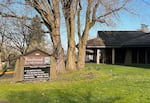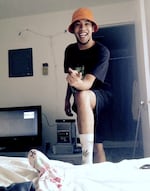The estate representing a man killed by Portland police in 2022 filed a federal civil rights lawsuit Thursday against the city, accusing officers of using excessive force and the city of negligence because officers failed to provide timely medical care.
Officer Christopher Sathoff fired an AR-15 rifle three times at Immanueal “Manny” Clark as he ran from police, according to the lawsuit and testimony presented to a grand jury. One bullet struck Clark in his back.
Clark was unarmed. The 30-year-old was shot after police incorrectly identified the vehicle he was in as part of an attempted armed robbery. The victim in the robbery attempt initially identified the suspects as three or four white men traveling in a gray sedan. Clark was Black.
Clark died two days later at the hospital. Sathoff was not criminally charged. Nearly a year and a half after the incident, Portland police are still conducting an internal investigation, Sgt. Kevin Allen said.
The Portland city attorney declined to comment on Thursday’s lawsuit.
On Nov. 19, 2022, around 12:25 a.m., emergency dispatchers received a call from someone in the parking lot of the SuperDeluxe restaurant on Southeast 50th Street and Powell Boulevard.
“Someone tried to rob me at gunpoint,” the caller told 911 dispatchers. “Can you hurry, please?”

Immanueal “Manny” Clark was shot in his back by Portland police on Nov. 19, 2022 and died two days later. Clark, 30, was incorrectly identified as a suspect in an attempted armed robbery. He was shot by Officer Christopher Sathoff as he ran from police, according to a lawsuit filed Thursday. Clark was unarmed. He's pictured here in this undated photo provided by his attorney.
Courtesy of Jesse Merrithew
When the dispatcher asked the caller to describe the suspect, the caller said there were three or four “white, definitely white,” men. The man who held the handgun at the SuperDeluxe wore a ski mask and a black hoodie, the caller said.
The caller then told the dispatcher that the suspects had left the restaurant parking lot and headed west on Powell Boulevard toward downtown Portland.
Police ended up pursuing a car with three people traveling east on Powell.
Six minutes after the initial 911 call, a patrol sergeant 30 blocks away from the SuperDeluxe saw a vehicle with three people inside driving east on Powell.
“I could see the silhouette of like three people in the vehicle as it was being silhouetted from vehicles traveling westbound,” Sgt. Michael Francis testified to a grand jury last August.
According to dispatch recordings, Francis said the vehicle turned south on Cesar Chavez Boulevard and took off. He said he lost sight of the car around Holgate Boulevard, not far from the Trader Joe’s.
“It was doing about 75, 80 [miles per hour],” Francis radioed to dispatchers, according to a recording provided by attorneys representing Clark’s estate. “Based upon driving behavior, my guess is that it cut eastbound possibly, like, Woodstock-ish area.”
By that point, Portland police were using the bureau’s airplane to search for the vehicle. Francis said the vehicle he was following was gray, similar to the description of the car the caller from the SuperDeluxe had identified.
Sgt. Daniel Barnard picked up the search. He was operating an infrared camera system from inside the airplane, some 4,500 feet in the air. Rather than finding a gray vehicle moving east on Woodstock Boulevard as Francis “guessed,” Barnard radioed to officers on the ground that he had spotted a “silvery, grayish” vehicle moving westbound on nearby Southeast Steele Street.
Barnard told fellow officers over the police radio that the car caught his eye because it was in the “rough area,” as the attempted robbery and “it’s silver or gray as best as I can tell.”
During the grand jury hearings, he testified that the vehicle also gave off a lot of heat through the infrared camera he was operating, a sign it may have been recently driving fast.
“I’m getting, in particular, interested in this car, because it’s the only car I’m seeing in the area,” Barnard testified. “It’s kind of driving [at] higher speeds. It looks like it’s been driven hard.”

Immanueal “Manny” Clark was shot in his back by Portland police on Nov. 19, 2022 and died two days later. Clark was shot in the parking lot of the Reedwood Friends Church in southeast Portland, pictured here on March 7, 2024.
Conrad Wilson / OPB
Around 12:36 a.m., Barnard radioed that the vehicle had pulled into the parking lot of Reedwood Friends Church on Southeast Steele Street, directly across the street from Reed College.
In the lawsuit filed Thursday, the attorneys for Clark’s estate contend that police didn’t have probable cause to believe anyone standing around the car had been involved in the attempted robbery at gunpoint outside the SuperDeluxe. The lawsuit states police lacked probable cause or reasonable suspicion to believe anyone in the car was armed. It also contends there wasn’t enough evidence that the car officers were moving in on was even the same vehicle Francis pursued, “much less the same car in which the attempted robbery suspects had fled.”
On the ground, a group of eight officers gathered near the church and decided to conduct what police called a “high-risk” stop. From the air, Barnard radioed that the vehicle in the church parking lot that they were converging on was occupied by three people. Back at the SuperDeluxe, the victim confirmed to police there were four people who attempted to rob him, which an officer broadcast over the radio less than two minutes before officers moved in on Clark in the church parking lot.
At the church, officers pulled up in two vehicles and turned on bright, forward-facing “take-down” lights that the lawsuit states “illuminate the area in front of the car and are blinding to anyone looking at the lights.”
As the officers were getting out of their vehicles, the lawsuit states, Clark and another man in the gray car ran. Both were Black.
“All of the attempted robbery suspects were white men,” the lawsuit notes. “Clark made no threats to the police prior to or while he was running away.”
Sathoff fired three shots.
“One of the men is holding his waist running, northbound, Black males, dark clothing,” one officer said over the radio.
One bullet struck Clark in the back. He fell to the ground “bleeding profusely and calling out for help,” the lawsuit states. “The police then left him to lay on the concrete parking lot, writhing in pain and bleeding out, for 26 minutes before providing any medical attention.”
During the grand jury, prosecutors asked Sathoff why he and other officers waited by their squad cars.
“We couldn’t just move up without cover,” Sathoff testified. “Especially after something like this happens, we want to slow things down. Because if we just rush up, we’re giving up our entire cover right here.”
Sathoff testified he believed Clark was armed.

Immanueal “Manny” Clark was shot in his back by Portland police on Nov. 19, 2022 and died two days later. Clark, 30, was incorrectly identified as a suspect in an attempted armed robbery. He was shot by Officer Christopher Sathoff as he ran from police, according to a lawsuit filed Thursday. Clark was unarmed. He's pictured here in this undated photo provided by his attorney.
Courtesy of Jesse Merrithew
A minute after Clark was shot, an ambulance arrived nearby that could have responded, but it was kept from the scene for 25 minutes, according to the lawsuit.
Portland police are required to give “emergency medical aid to ill or injured persons,” the lawsuit notes, accusing city law enforcement of not doing that in this case as well as in others. In the lawsuit, the attorneys accuse the city of a “custom and practice” of not providing timely medical care to people shot by Portland police.
“By the time Clark arrived at [Oregon Health & Sciences University] there was nothing the doctors could do to save his life,” the lawsuit states.
The case went before a grand jury last summer, and jurors opted not to file criminal charges against Sathoff.
A memo from the Multnomah County District Attorney’s Office dated September 28, 2023, summarized the facts of the case and a prosecutor’s legal analysis. Clark did not have a firearm and video footage from the SuperDeluxe on Powell confirmed the vehicle Clark was in was not involved in the attempted armed robbery.

Portland Police Bureau, at 1111 Southwest 2nd. Ave., Portland, Ore., July, 2023.
Caden Perry / OPB
“It was determined that none of those facts were known to Officer Sathoff at the time of the shooting,” the memo states. Prosecutors also noted that Clark had outstanding arrest warrants for possessing a stolen vehicle and fleeing a police officer. The vehicle he was driving on Nov. 19 had been reported stolen.
“These facts were known only after the investigation was conducted and is provided as information only to explain the probable reason why the vehicle traveled at the speeds and manner in which it was observed to be driving and why at least some of the occupants fled the vehicle after being contacted by police,” prosecutors wrote in their memo. “Under Oregon law, however, only the reasonable belief of the officer under the totality of information known to the officer at the time of the shooting is relevant to the analysis of the use of deadly physical force.”
Sathoff told grand jurors he’d believed Clark was armed and could be running for cover from which he could shoot at officers.
“To be very clear, for the grand jury, though, did you ever actually see a gun?” Kurt Miller, an assistant attorney general with the Oregon Department of Justice, asked.
“I don’t recall seeing a gun,” Sathoff said. “I just remembered seeing his hand still in his pocket”
“Did you see any objects in his pocket?” Miller asked. “Was the pocket full to you?”
“I couldn’t see, but I remember him, he kept his hand in his pocket, and it looked like he was trying to pull at something,” Sathoff testified. “I felt it was reasonable to assume that he was pulling out a gun at that time, being that he matched the description, and he had committed a felony crime.”
Later a member of the grand jury asked: “When you shot, you saw his back only?”
“It was, like, kind of his side,” Sathoff replied. “I couldn’t see his right hand.”
“And you shot at his back?” a grand juror asked again.
“Yes,” Sathoff said. “Yes.”
